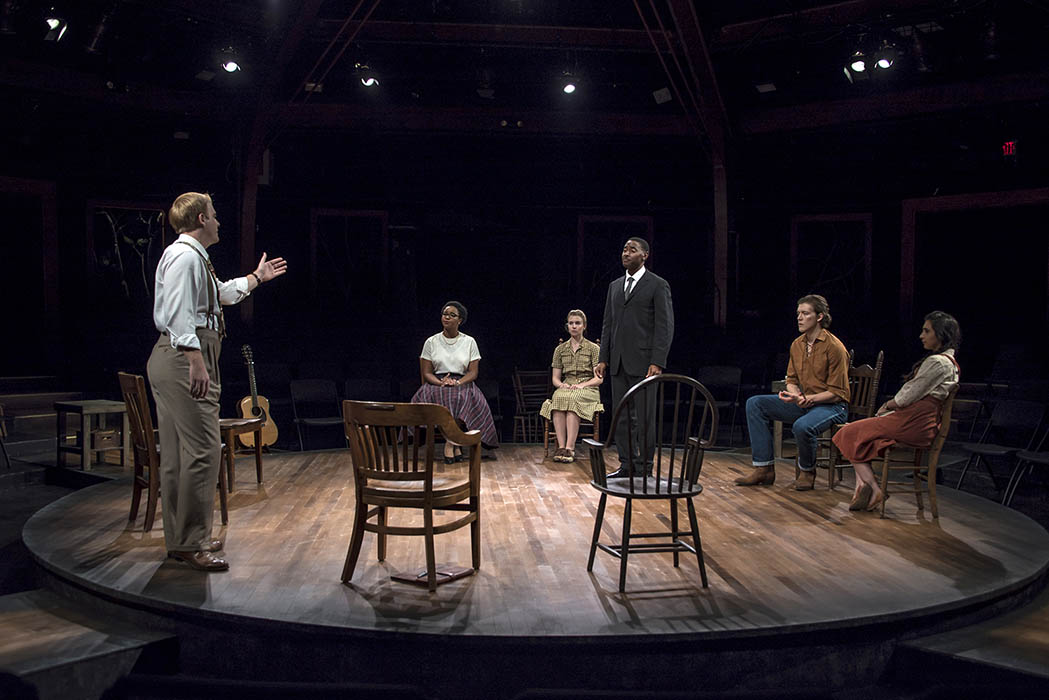In the spring of 1955, much of the Southern U.S. was a simmering kettle of racial segregation, civil rights repression, and worker/workplace abuses—one that was on the verge of boiling over into a full scale struggle against those economic and civil rights injustices. With that time and atmosphere of conflict as a starting point, playwright Anthony Clarvoe has focused in on the rural Grundy County of 1955 Tennessee and the organization known then as the Highlander Folk School for his new play, People Where They Are, currently getting its world premiere at Clarence Brown Theatre’s Carousel Theatre. While the story of Highlander and its goals of educating and agitating for change may be an unfamiliar or misunderstood one among today’s audience, Clarvoe has succeeded with a superbly compelling narrative that reveals and explains. Most importantly, he draws important parallels between the racial and socio-economic struggles of the 1950s and 60s and similar issues that face contemporary American society such as immigration, voter suppression, and LGBTQ rights.
Bringing Clarvoe’s drama and characters to life are six uniformly excellent and absolutely electrifying performances by a cast of CBT’s MFA actors, co-directed with a quietly restrained intensity and dramatic rhythm by Calvin MacLean and Dee Dee Batteast. The play, commissioned from Clarvoe by the Clarence Brown Theatre specifically for the six actors, skillfully uses its characters as both a symbolic “type” and as an individual. In his notes, Clarvoe indicates that his characters are combinations of several actual historic people, and that he has re-arranged the timeline of actual events for the sake of dramatic storytelling.
The storyline of People Where They Are is constructed around an educational session at the Highlander Folk School in the pre-Montgomery bus boycott days of 1955, involving four invited, outsider “students” along with the group leader, Mrs. Clark (Aleah Vassell) and a helper, Mr. Carawan (Owen Squire Smith).
[Note: Clark and Carawan are based on the real-life Septima Clark and musician Guy Carawan]
The visitors are May (Brittany Marie Pirozzoli), a mountain housewife turned labor organizer; Emma (Brenda Orellana), a Mexican-American suffering from ethnic and class abuse; Ned (Collin Andrews), a compromised white man from the Atlanta office of the CIO; and John (Jade Arnold), a northern black man who presents himself initially as the son of a minister. As their session moves into a second day, personal stories begin to flow and character complexities emerge allowing each actor to paint a portrayal that not only reveals their character, but ties in subject matter relevant to an audience in 2019.

Arnold’s end-of-Act I speech in which his “John” confronts the hidden white supremacy and red-baiting of Andrews’ marvelous good-old-boy “Ned” was a masterpiece of delivery. Pirozzoli’s creation of “May”—hardened jaw, stiffened shoulders, and flowing mountain dialect—was brilliant. Orellana painted her “Emma” with a complexity as well, balancing strength with softness, which gave her surprise a real poignance. Smith’s Act II emphatic speech revealing how he resists violence was a remarkable contrast to his character’s otherwise gentle demeanor. Vassell was the moderating dramatic glue in every scene, allowing the face of Mrs. Clark only the occasional, carefully controlled betrayal of irritation, anger, or impatience.
Just as the Highlander Folk School was raided on occasions, both by police and by local vigilantes, Clarvoe has inserted a generic, but frightening, raid into Act II. In this case, he alternately expands and compresses time for the sake of tension and impact, with all of the actors delivering speeches on how they face their attackers and deal with violence and danger. Aided in this sequence of reveals was lighting by designer Bill Miller, kinetically punctuated by the slowly rotating blades of an overhead fan.
Wisely, director MacLean has chosen to do People Where They Are completely in the round in the Carousel Theatre, a configuration that has not been used there by CBT productions for quite a few seasons. With a circular platform for the action completely surrounded by the audience, the dramatic focus is heightened, pulling the audience closer. While true in-the-round staging complicates how action can unfold and how actors must present to the audience, MacLean, cast, and designers truly got it right.
The visually simple set of platform, overhead fan, chairs, and a circumference of rurally suggestive frames by Carrie Ferrelli worked beautifully for the actors. The individuality of each actor (and their “type”) was perfectly captured by costume designer John Merritt. Mike Ponder gave the atmospheric and suggestive sound effects his usual subtle touch that is both expressionistic and impressionistic.
While I rarely make such a direct and obvious recommendation, I am suggesting that all theatre-goers place People Where They Are on their must-go list during the play’s run in the Carousel Theatre through October 20. This is brilliant theatre, with brilliant ensemble and individual performances. But, importantly, it contains the admonition that while some things in our socio-political existence change for the better, other issues evolve and hide in the shadows biding their time. Highlander, now the Highlander Research and Education Center in New Market, TN, has also evolved to meet the challenges to social progress. The lesson of their existence is a lesson that everyone should know about and understand if we are ever to confront the demons of our past.









An excellent review of an excellent performance!